Testing The World’s Best APUs: Desktop AMD Ryzen 4750G, 4650G and 4350G
by Dr. Ian Cutress on December 16, 2020 10:30 AM ESTCPU Benchmarks: Synthetic
All of our benchmark results can also be found in our benchmark engine, Bench.
Dwarf Fortress 0.44.12: Link
Emulating the ASCII interfaces of old, this title is a rather complex beast, which can generate environments subject to millennia of rule, famous faces, peasants, and key historical figures and events. The further you get into the game, depending on the size of the world, the slower it becomes as it has to simulate more famous people, more world events, and the natural way that humanoid creatures take over an environment. Like some kind of virus.
For our test we’re using DFMark. DFMark is a benchmark built by vorsgren on the Bay12Forums that gives two different modes built on DFHack: world generation and embark. These tests can be configured, but range anywhere from 3 minutes to several hours. After analyzing the test, we ended up going for three different world generation sizes:
- Small, a 65x65 world with 250 years, 10 civilizations and 4 megabeasts
- Medium, a 127x127 world with 550 years, 10 civilizations and 4 megabeasts
- Large, a 257x257 world with 550 years, 40 civilizations and 10 megabeasts
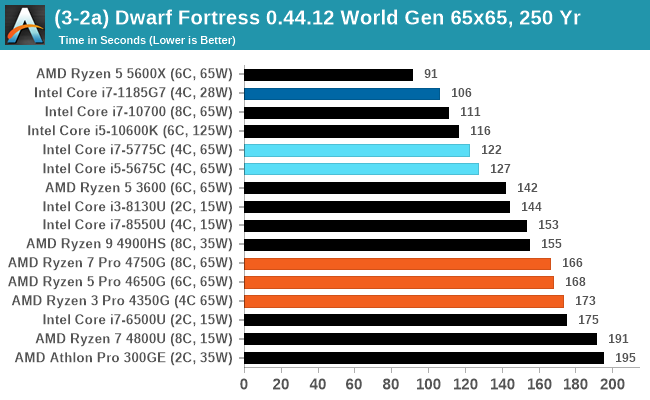
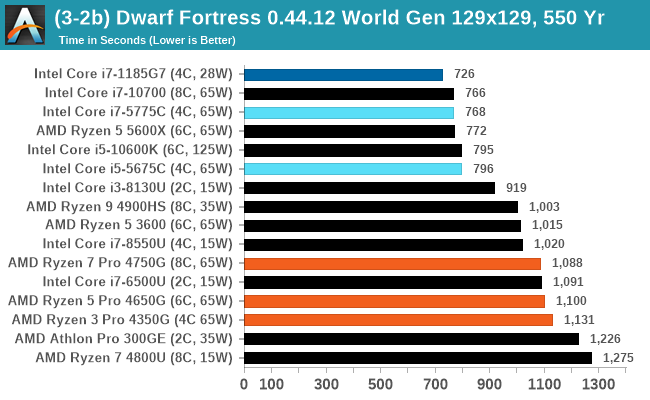
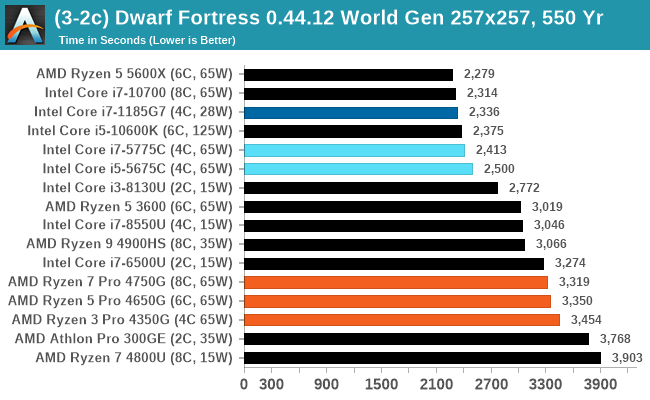
Dolphin v5.0 Emulation: Link
Many emulators are often bound by single thread CPU performance, and general reports tended to suggest that Haswell provided a significant boost to emulator performance. This benchmark runs a Wii program that ray traces a complex 3D scene inside the Dolphin Wii emulator. Performance on this benchmark is a good proxy of the speed of Dolphin CPU emulation, which is an intensive single core task using most aspects of a CPU. Results are given in seconds, where the Wii itself scores 1051 seconds.

3D Particle Movement v2.1: AVX2/AVX512
This is the latest version of this benchmark designed to simulate semi-optimized scientific algorithms taken directly from my doctorate thesis. This involves randomly moving particles in a 3D space using a set of algorithms that define random movement. For v2.1, we also have a fully optimized AVX2/AVX512 version, which uses intrinsics to get the best performance out of the software.
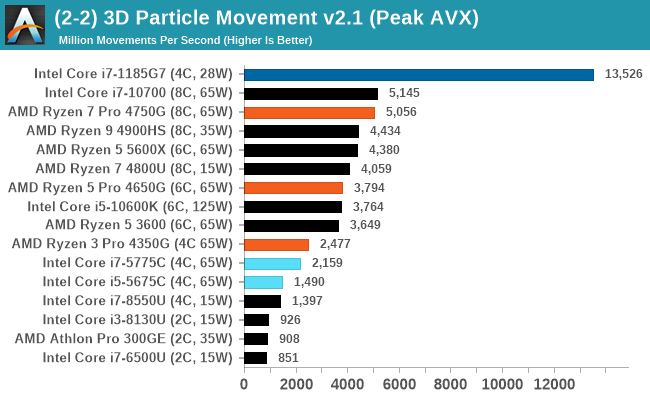
Tiger Lake wins here as it has an AVX512 unit.
y-Cruncher 0.78.9506: www.numberworld.org/y-cruncher
If you ask anyone what sort of computer holds the world record for calculating the most digits of pi, I can guarantee that a good portion of those answers might point to some colossus super computer built into a mountain by a super-villain. Fortunately nothing could be further from the truth – the computer with the record is a quad socket Ivy Bridge server with 300 TB of storage. The software that was run to get that was y-cruncher.
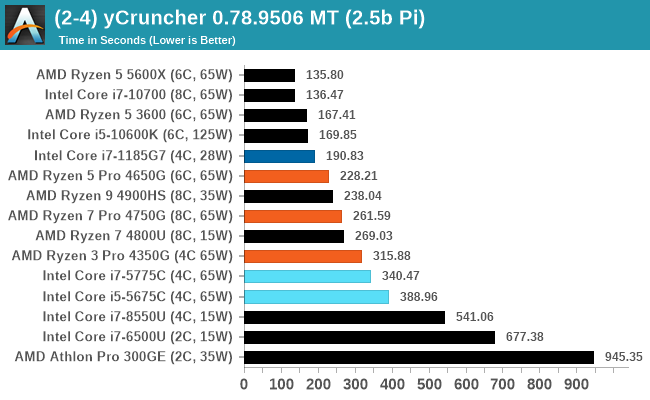
This is another AVX-512 test.
Linux OpenSSL Speed: SHA256
One of our readers reached out in early 2020 and stated that he was interested in looking at OpenSSL hashing rates in Linux. Luckily OpenSSL in Linux has a function called ‘speed’ that allows the user to determine how fast the system is for any given hashing algorithm, as well as signing and verifying messages.
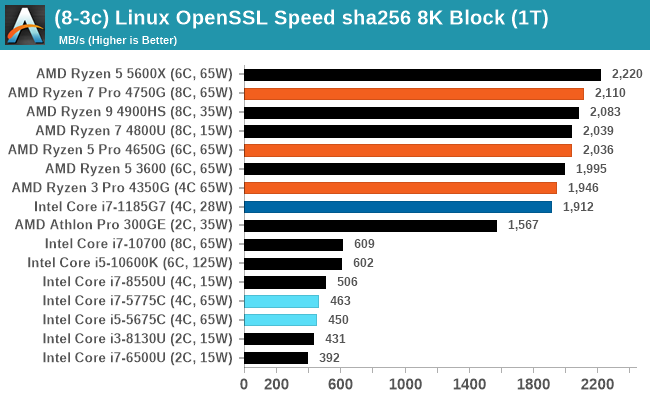
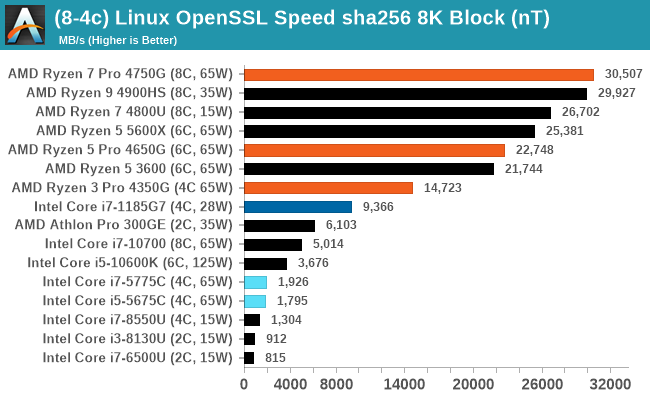










104 Comments
View All Comments
Cloakstar - Wednesday, December 16, 2020 - link
(All tests were done with 2 sticks of RAM, so channel interleave only.)tamsysmm - Wednesday, December 16, 2020 - link
I'd say that is a bit optimistic. I got speedup on my testing but not 33%Unigine Superposition 1.0
Resolution: 1920 x 1080 - Mode: Fullscreen - Quality: Low - Renderer: OpenGL
2 x 8192 MB 3600MHz Kingston, avg 34.7 fps (max 47.9 fps), (HX436C17PB4AK2/16)
4 x 8192 MB 3600MHz Kingston, avg 37.0 fps (max 51.9 fps), (HX436C17PB4AK2/16*2)
peevee - Wednesday, December 16, 2020 - link
4 channels of DDR5 directly on the APU package (not routed through MB), 200W+, combining GPU power with a discrete GPU, at least of the same architecture, and we are talking (I am buying).ArcadeEngineer - Sunday, December 20, 2020 - link
Four channels worth of DDR5 chips is far larger than any cpu socket.peevee - Wednesday, December 23, 2020 - link
3 sides of a CPU board can fit 4 SODIMM slots. Even 8, 2 one above the other. Can be horizontal, vertical (but that will limit the size of a radiator) or slanted.Danvelopment - Wednesday, December 16, 2020 - link
These chips were a real disappointment.Not because of their performance, but because of their OEM only status.
They were exactly what I needed for an 8 core mini-ITX server, with good multi...single threaded performance (many single threaded streams), a pico-PSU and no expansion slots and they were never made available. Some stock did appear here and there as the article explains, but the pricing was extreme.
Thus I still have a huge full tower with a R7-2700 and my next server will be either be an 8 core Xeon E5-V2 on one of those crazy Chinese x79 motherboards with dual m.2 NVMe slots in ITX.
Or a massive 2x14 core 2GHz dual Xeon E5-v3 with a total system price close to buying just one of those processors.
I lose out on single thread but gain on pure output.
foxalopex - Wednesday, December 16, 2020 - link
If you don't mind gambling a bit (I did and got what I was looking for), these chips can be found on aliexpress for a reasonable price.Lucky Stripes 99 - Thursday, December 17, 2020 - link
Similar story here. I wanted to build a couple of nearly silent mini-ITX APU systems to replace my older Haswell desktops and I kept hitting walls. Zen+ APUs are getting long in the tooth and are incompatible with newer A520 and B550 boards (and X570 isn't optimal either). Zen 2 APUs have been stupidly expensive until recently and have questionable warranty support when purchased from Asian resellers. Zen 3 APUs are coming, but we don't know when and if they'll be OEM-only like their predecessor. Intel Comet Lake desktop CPUs lack an Iris Plus iGPU option, so you're stuck with horrible UHD 630 performance. Rocket Lake CPUs with Xe iGPU are coming, but given Intel's recent schedule misses, who knows when.lmcd - Friday, December 18, 2020 - link
Rocket Lake won't slip, it's a 14nm part lolozzuneoj86 - Wednesday, December 16, 2020 - link
I have to echo the comments of others. Why benchmark 360p or 480p for integrated graphics? How is that even remotely relevant?The funny thing is, I work with retro computers and as I type this I have a 3dfx Voodoo 2 on a test bench right now, stress (heat) testing at 640x480. It runs like butter at that res, at least in games from 1997-1999.
Why would anyone need to know how a modern IGP runs at a resolutions similar to or lower than what 3d accelerators used 23 years ago? What games even support 360P (480x360... a display resolution not normally used by PCs at any time period), and how could you even read menus at that res??